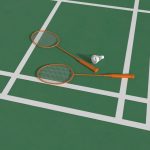Mastering the Art of Table Tennis
Description
Table tennis, often referred to as ping pong, is a fast-paced sport that combines agility, precision, and strategy. Originating in England during the late 19th century as a parlor game, it has evolved into a competitive sport governed by the International Table Tennis Federation (ITTF). The game is played on a rectangular table divided by a net, with players using small paddles to hit a lightweight ball back and forth.
The objective is to score points by making the ball land on the opponent’s side of the table in such a way that they cannot return it. The rules of table tennis are relatively straightforward, making it accessible to players of all ages and skill levels. A match is typically played in a best-of-five or best-of-seven format, with players serving two points each until one player reaches 11 points, at which point they must win by at least two points.
The scoring system encourages quick exchanges and strategic play, as players must not only focus on their own shots but also anticipate their opponent’s responses. Understanding these fundamentals is crucial for anyone looking to delve deeper into the sport, as they form the foundation upon which all advanced techniques and strategies are built.
Key Takeaways
- Table tennis is a fast-paced game played on a small table with a lightweight ball and paddles.
- The correct grip and stance are essential for maintaining control and power in table tennis.
- Mastering the serve and return is crucial for gaining an advantage over your opponent.
- Developing good footwork and movement is key to reaching and returning shots effectively.
- Improving control and spin on the ball can give you an edge in competitive play.
Perfecting Your Grip and Stance
The grip and stance in table tennis are critical components that can significantly influence a player’s performance. There are primarily two types of grips: the shakehand grip and the penhold grip. The shakehand grip resembles a handshake and is favored by many players for its versatility, allowing for both forehand and backhand strokes with ease.
In contrast, the penhold grip, which involves holding the paddle like a pen, offers greater control for certain types of shots but can limit backhand options. Each grip has its advantages and disadvantages, and players should experiment to find which one feels most comfortable and effective for their style of play. Equally important is the stance a player adopts while playing.
A balanced stance typically involves keeping the feet shoulder-width apart, with knees slightly bent to allow for quick lateral movements. The weight should be distributed evenly on both feet, enabling players to shift their center of gravity as needed. A forward-leaning posture can enhance readiness and responsiveness, allowing players to react swiftly to their opponent’s shots.
Practicing these elements in tandem can lead to improved stability and control during gameplay, setting the stage for more advanced techniques.
Mastering the Serve and Return

The serve is one of the most critical aspects of table tennis, as it initiates each point and can set the tone for the rally that follows. A well-executed serve can catch an opponent off guard, providing an immediate advantage. There are various types of serves, including topspin, backspin, and sidespin serves, each designed to create different challenges for the receiver.
For instance, a topspin serve bounces high and fast, making it difficult for opponents to return effectively, while a backspin serve can cause the ball to drop quickly after bouncing, often leading to errors in judgment. Equally important is mastering the return of serve. A successful return requires not only good timing but also an understanding of the spin and speed of the incoming ball. Players should focus on reading their opponent’s body language and paddle angle to anticipate the type of serve being delivered. Developing a variety of return techniques—such as aggressive returns that aim for placement or defensive returns that prioritize control—can enhance a player’s ability to counter different serves effectively.
By honing both serving and returning skills, players can gain a significant edge in matches.
Developing Your Footwork and Movement
| Metrics | Value |
|---|---|
| Number of footwork drills practiced | 20 |
| Time spent on agility training | 2 hours per week |
| Improvement in speed and quickness | 10% |
| Number of directional changes per minute | 15 |
Footwork is often considered the backbone of effective table tennis play. Quick and agile movement allows players to position themselves optimally for each shot, ensuring they can execute their strokes with precision. Good footwork involves not only speed but also proper technique; players should practice moving laterally, forward, and backward while maintaining balance.
A common drill involves setting up cones or markers around the table and practicing moving to each one in response to an imaginary shot, simulating real-game scenarios. In addition to lateral movement, players must also develop their ability to pivot and change direction quickly. This agility is crucial when responding to powerful shots from opponents or when attempting to reposition oneself after an initial strike.
Incorporating footwork drills into regular training routines can significantly improve overall performance. For example, shadow play—where players practice their strokes without a ball—can help reinforce proper foot positioning and movement patterns while allowing them to focus on technique without distractions.
Improving Your Control and Spin
Control in table tennis refers to a player’s ability to place the ball accurately on the opponent’s side of the table while managing its speed and spin. Developing control requires consistent practice and an understanding of how different strokes affect the ball’s trajectory. Players should focus on hitting the ball with varying degrees of force; light touches can create delicate placements while harder strikes can generate speed.
Practicing with targets on the table can help players refine their accuracy and develop a better sense of control over their shots. Spin is another essential element that can dramatically alter the dynamics of a match. By imparting spin on the ball—whether topspin, backspin, or sidespin—players can make it more challenging for opponents to predict its path or execute effective returns.
Mastering spin involves understanding how to angle the paddle during contact with the ball; for instance, brushing up on the ball creates topspin while brushing down generates backspin. Players should experiment with different spins during practice sessions to see how they affect their opponents’ responses, ultimately leading to more strategic gameplay.
Learning Advanced Techniques and Strategies

As players progress in their table tennis journey, they may wish to explore advanced techniques that can elevate their game further. One such technique is the loop stroke, characterized by its high arc and heavy topspin. This stroke is particularly effective against backspin balls, allowing players to counteract their opponent’s spin while generating offensive pressure.
Learning how to execute a loop requires practice in timing and paddle angle; players must brush up on the ball while following through in an upward motion. Another advanced strategy involves understanding when to employ aggressive versus defensive play styles during matches. Aggressive players often seek to dominate rallies with powerful shots and quick movements, while defensive players may focus on returning balls with precision and waiting for opportunities to counterattack.
Developing an awareness of one’s own strengths and weaknesses—and those of opponents—can inform strategic decisions during gameplay. Players should analyze match footage or engage in discussions with coaches or peers to identify areas for improvement and refine their overall approach.
Enhancing Your Mental Game and Focus
Table tennis is not solely a physical endeavor; mental fortitude plays a crucial role in achieving success on the table. Players must cultivate focus and concentration during matches, as distractions can lead to costly errors or missed opportunities. Techniques such as visualization—where players mentally rehearse successful shots or strategies—can enhance confidence and performance under pressure.
Additionally, mindfulness practices can help players remain present during matches, reducing anxiety and improving decision-making. Another aspect of mental preparation involves developing resilience in the face of adversity. Matches can be unpredictable; players may encounter challenging opponents or experience unexpected setbacks during gameplay.
Building mental toughness allows athletes to maintain composure and adapt their strategies as needed. Engaging in positive self-talk or setting specific performance goals can help reinforce a strong mental game, ultimately contributing to improved outcomes in competitive settings.
Practicing Drills and Training Routines
To translate skills into effective gameplay, consistent practice through targeted drills is essential.
For example, a common drill involves practicing serves against a wall or partner while varying spin types; this helps reinforce muscle memory while enhancing adaptability.
In addition to technical drills, incorporating match simulations into training can provide valuable experience under pressure. Players can engage in practice matches against peers or utilize video analysis tools to review their performance critically. This feedback loop allows athletes to identify strengths and weaknesses while refining strategies over time.
By committing to structured training routines that encompass both skill development and match preparation, players can steadily progress toward their goals in table tennis.
If you’re a fan of Table Tennis, you may also enjoy reading about the popular mobile game “Where’s My Water? 2”. This puzzle game challenges players to help Swampy the Alligator navigate through various levels by solving physics-based puzzles. Check out this article to learn more about this fun and addictive game.
FAQs
What is table tennis?
Table tennis, also known as ping-pong, is a sport in which two or four players hit a lightweight ball back and forth across a table using small bats.
What are the basic rules of table tennis?
The basic rules of table tennis include serving the ball diagonally over the net, allowing the ball to bounce once on each side of the table, and scoring points when the opponent fails to return the ball.
What equipment is needed to play table tennis?
To play table tennis, players need a table tennis table, table tennis bats (also known as paddles or rackets), table tennis balls, and a net.
What are the health benefits of playing table tennis?
Playing table tennis can improve hand-eye coordination, reflexes, and balance. It also provides a good cardiovascular workout and can help improve mental acuity.
What are the different types of table tennis shots?
Common table tennis shots include the forehand drive, backhand drive, topspin, backspin, and smash. Players use a combination of these shots to outmaneuver their opponents.
What is the history of table tennis?
Table tennis originated in England in the late 19th century as an indoor version of lawn tennis. It has since become a popular sport worldwide and is an Olympic event.





